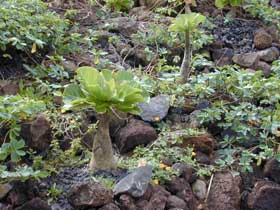Brighamia insignis
Volcano palm ( Brighamia insignis )
The volcano palm ( Brighamia insignis ), even Hawaii palm, is a species of the genus Brighamia within the family of Bellflower Family ( Campanulaceae ). It is endemic to some of the islands of Hawaii and belongs to the wild species threatened with extinction.
- 6.1 Notes and references
- 6.2 Literature
Naming
Scientific name
The genus was given its botanical name Brighamia in honor of American botanist William Tufts Brigham, an explorer and collector of Hawaiian plants. This, like all scientific names ( components therefor ) in biology also Latin, Art epithet means insignis, excellent ',' remarkable ',' characteristic '.
Trivial names
The first part of each of their German trivial name, "Vulkan ~ " or " Hawaii ~ " Brighamia insignis owes its endemic occurrence in the Hawaiian Islands, which are known to be is volcanic islands. The second part of word " ~ palm " comes only from their palms very similar morphology and growth habit, is so misleading in that it insignis not a plant of the palm family or the order of the palm -like in Brighamia (see Scheme ).
Your common name is the Anglo -Saxon world " Ōlulu " or " Alula " ( hawaiian. ( !)); it is there, colloquially also "cabbage on a stick " (English; , cabbage on a stick ') called what ("~ palm " in German as ) is also derived from the appearance of the plant.
As an ornamental plant Brighamia carries insignis sometimes the ( English ) name "Hawaiian Palm ", without, however, that this would be a regular or common (trivial ) name for the plant in the Anglo- Saxon countries.
Description
Brighamia insignis is a deciduous, rarely branching stem succulent. The weichfleischige, containing milky sap stem is upright and reaches stature heights of 1 to 3 ( to 5) meters. Its bark is smooth, at first green, then gray, and covered with the scars of dropped leaves. During the growing season the thin, non- succulent leaves are spread out in a rosette at the apex of the stem. They are obovate, about 12 to 30 cm long, 6-12 cm wide and bright green.
The approximately 10 -cm-long inflorescences with four to seven flowers appear laterally from the leaf axils. The flowers open at night. There are five 1-6 mm long sepals present. The five petals are fused Roehrig, has a diameter of 3 to 4 mm and is about 13 cm long. Their outspread tail are white to yellow and about 1.8 to 2.5 × 1 cm in size. The first maturing, laterally projecting five stamens are fused into a tube. After her withering matures, the female part of the flower with inferior, zweikammerigem ovary. The elongated, about 14 × 10 mm, zehnrippige fruit capsule splits when ripe lengthwise into four parts. Her numerous, pale seeds are about 1 mm in size.
Ecology
In nature, pollination takes place by moths with very long, in which at least 13 cm deep flowers reaching suckers. As a pollinator on the island of Molokai apparently missing and possibly extinct, the number of plants of the local Bar Shape declined dramatically. To rescue this local form of the plants are now pollinated by hand. It was awakened by unprofessional and rather biased coverage of the now widespread impression that the complete type would be threatened by the loss of a pollinator extinction. In fact, the species is due to their naturally small and scattered populations as endangered.
Distribution and systematics
Brighamia insignis grows endemic to five islands of Hawaii. There it forms small populations on basalt cliffs near the sea. Due to the formation of several local types, which differ slightly in flowers and seeds, have been in the past, several species and varieties (such as Brighamia rockii H.St.John ) described, but now all are regarded as synonyms. The genus is thus Brighamia monotypic.
Cultivation
Except in succulent nurseries Brighamia insignis is sometimes offered in the plant trade. It was earlier this almost exclusively imported goods, ie not relied on in Central Europe plants, because in culture they soon turn out to be difficult and grow in opposite rhythm in winter, while they respect a rest period in the summer. In addition, they are susceptible to rot and many pests. The specimens offered nowadays in nurseries no longer come from wild stocks, but are propagated by meristem culture ( in vitro), both outside and within Central Europe (eg in the Netherlands).










